Vinayakumar R
Deep Learning Approach for Intelligent Named Entity Recognition of Cyber Security
Mar 31, 2020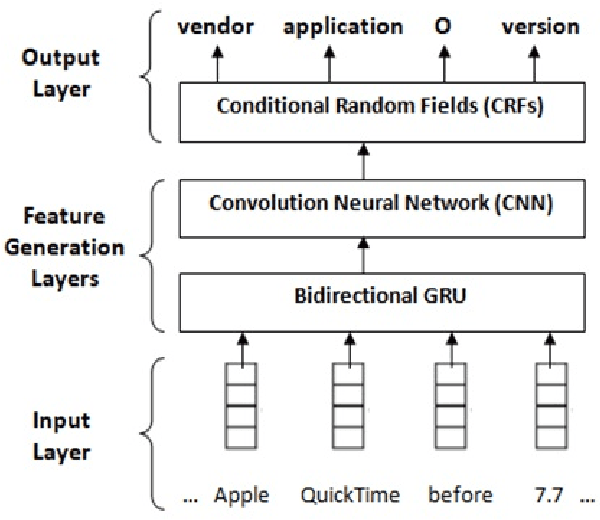
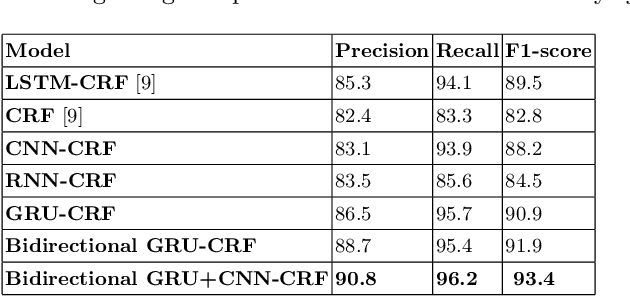
Abstract:In recent years, the amount of Cyber Security data generated in the form of unstructured texts, for example, social media resources, blogs, articles, and so on has exceptionally increased. Named Entity Recognition (NER) is an initial step towards converting this unstructured data into structured data which can be used by a lot of applications. The existing methods on NER for Cyber Security data are based on rules and linguistic characteristics. A Deep Learning (DL) based approach embedded with Conditional Random Fields (CRFs) is proposed in this paper. Several DL architectures are evaluated to find the most optimal architecture. The combination of Bidirectional Gated Recurrent Unit (Bi-GRU), Convolutional Neural Network (CNN), and CRF performed better compared to various other DL frameworks on a publicly available benchmark dataset. This may be due to the reason that the bidirectional structures preserve the features related to the future and previous words in a sequence.
Deep Learning Approach for Enhanced Cyber Threat Indicators in Twitter Stream
Mar 31, 2020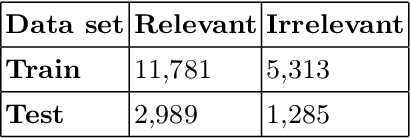
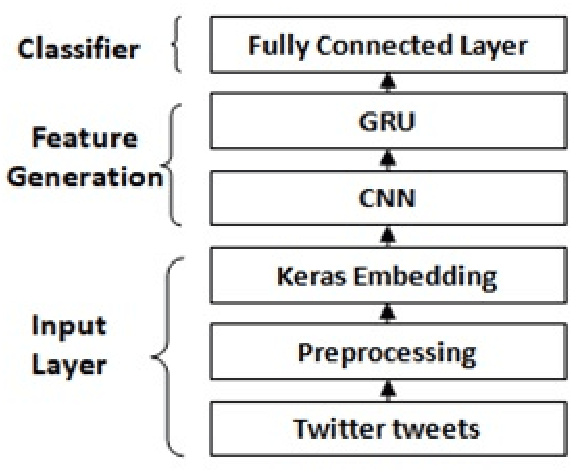
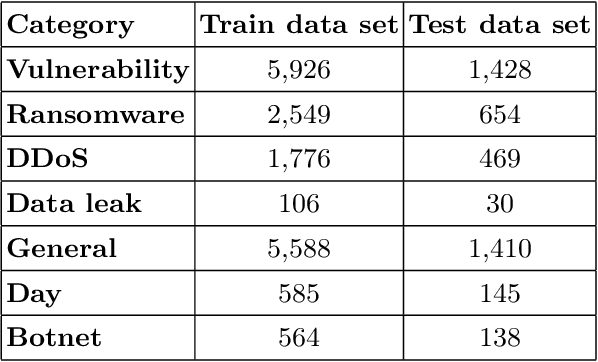
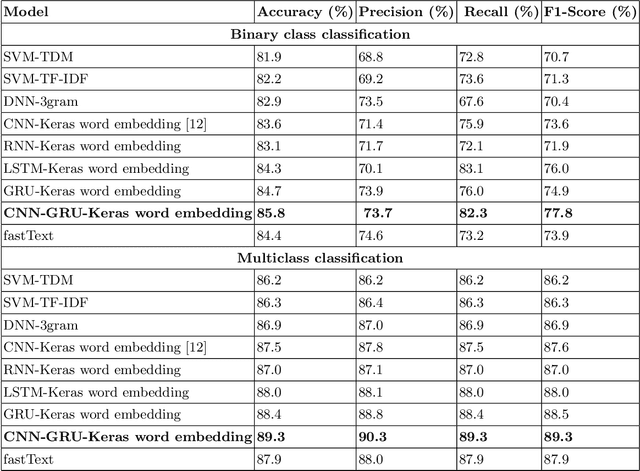
Abstract:In recent days, the amount of Cyber Security text data shared via social media resources mainly Twitter has increased. An accurate analysis of this data can help to develop cyber threat situational awareness framework for a cyber threat. This work proposes a deep learning based approach for tweet data analysis. To convert the tweets into numerical representations, various text representations are employed. These features are feed into deep learning architecture for optimal feature extraction as well as classification. Various hyperparameter tuning approaches are used for identifying optimal text representation method as well as optimal network parameters and network structures for deep learning models. For comparative analysis, the classical text representation method with classical machine learning algorithm is employed. From the detailed analysis of experiments, we found that the deep learning architecture with advanced text representation methods performed better than the classical text representation and classical machine learning algorithms. The primary reason for this is that the advanced text representation methods have the capability to learn sequential properties which exist among the textual data and deep learning architectures learns the optimal features along with decreasing the feature size.
Deep Learning based Frameworks for Handling Imbalance in DGA, Email, and URL Data Analysis
Mar 31, 2020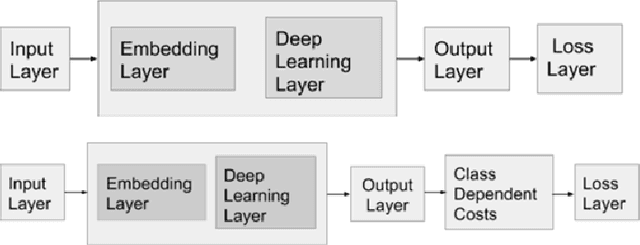
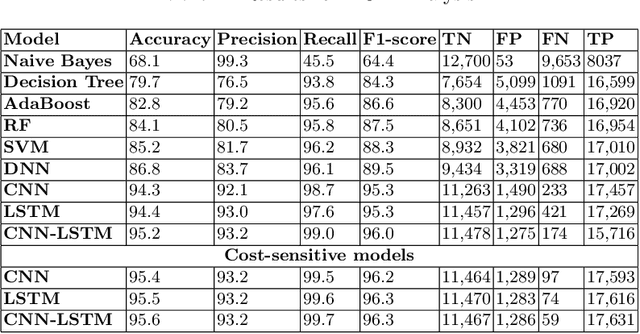
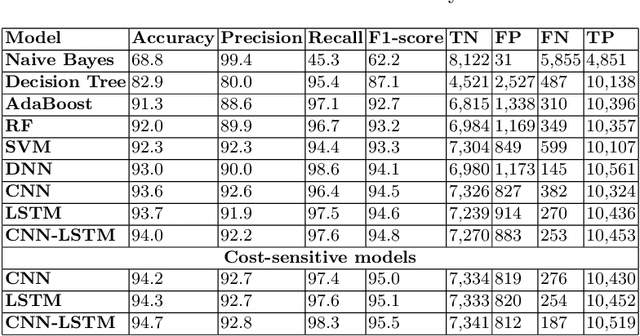
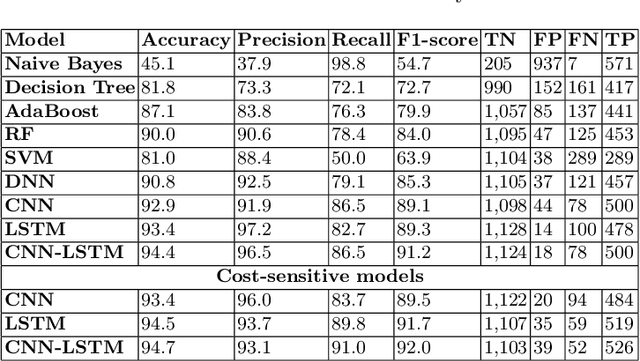
Abstract:Deep learning is a state of the art method for a lot of applications. The main issue is that most of the real-time data is highly imbalanced in nature. In order to avoid bias in training, cost-sensitive approach can be used. In this paper, we propose cost-sensitive deep learning based frameworks and the performance of the frameworks is evaluated on three different Cyber Security use cases which are Domain Generation Algorithm (DGA), Electronic mail (Email), and Uniform Resource Locator (URL). Various experiments were performed using cost-insensitive as well as cost-sensitive methods and parameters for both of these methods are set based on hyperparameter tuning. In all experiments, the cost-sensitive deep learning methods performed better than the cost-insensitive approaches. This is mainly due to the reason that cost-sensitive approach gives importance to the classes which have a very less number of samples during training and this helps to learn all the classes in a more efficient manner.
Intrusion detection systems using classical machine learning techniques versus integrated unsupervised feature learning and deep neural network
Oct 01, 2019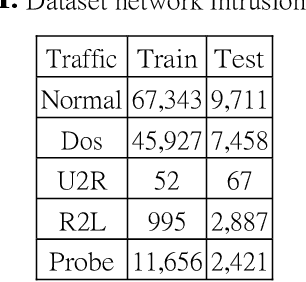


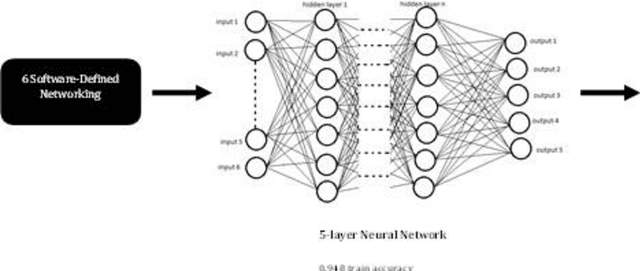
Abstract:Security analysts and administrators face a lot of challenges to detect and prevent network intrusions in their organizations, and to prevent network breaches, detecting the breach on time is crucial. Challenges arise while detecting unforeseen attacks. This work includes a performance comparison of classical machine learning approaches that require vast feature engineering, versus integrated unsupervised feature learning and deep neural networks on the NSL-KDD dataset. Various trials of experiments were run to identify suitable hyper-parameters and network configurations of machine learning models. The DNN using 15 features extracted using Principal Component analysis was the most effective modeling method. The further analysis using the Software Defined Networking features also presented a good accuracy using Deep Neural network.
Emotion Detection using Data Driven Models
Jan 10, 2019

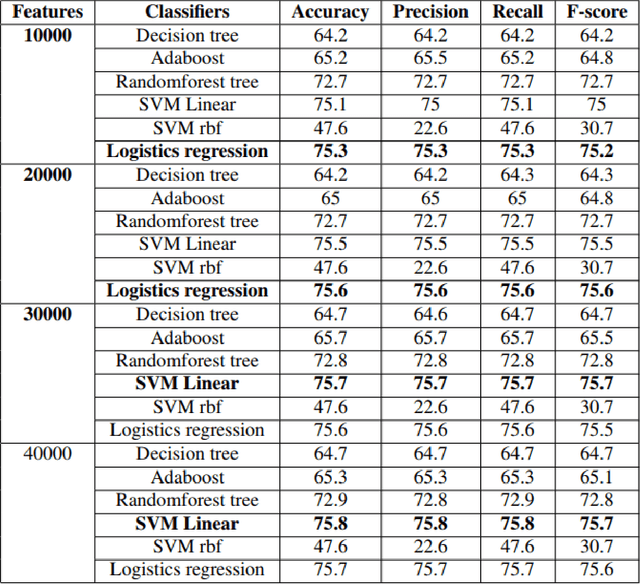

Abstract:Text is the major method that is used for communication now a days, each and every day lots of text are created. In this paper the text data is used for the classification of the emotions. Emotions are the way of expression of the persons feelings which has an high influence on the decision making tasks. Datasets are collected which are available publically and combined together based on the three emotions that are considered here positive, negative and neutral. In this paper we have proposed the text representation method TFIDF and keras embedding and then given to the classical machine learning algorithms of which Logistics Regression gives the highest accuracy of about 75.6%, after which it is passed to the deep learning algorithm which is the CNN which gives the state of art accuracy of about 45.25%. For the research purpose the datasets that has been collected are released.
RNNSecureNet: Recurrent neural networks for Cyber security use-cases
Jan 05, 2019


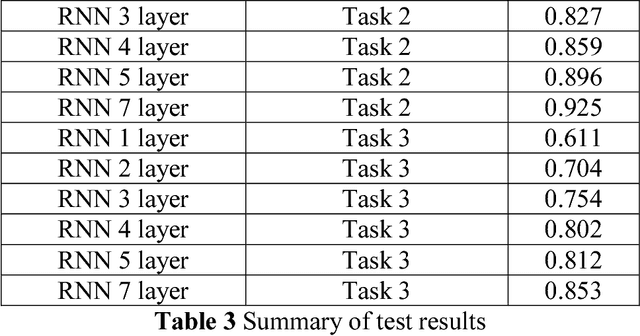
Abstract:Recurrent neural network (RNN) is an effective neural network in solving very complex supervised and unsupervised tasks. There has been a significant improvement in RNN field such as natural language processing, speech processing, computer vision and other multiple domains. This paper deals with RNN application on different use cases like Incident Detection, Fraud Detection, and Android Malware Classification. The best performing neural network architecture is chosen by conducting different chain of experiments for different network parameters and structures. The network is run up to 1000 epochs with learning rate set in the range of 0.01 to 0.5.Obviously, RNN performed very well when compared to classical machine learning algorithms. This is mainly possible because RNNs implicitly extracts the underlying features and also identifies the characteristics of the data. This helps to achieve better accuracy.
A Deep Learning Approach for Similar Languages, Varieties and Dialects
Jan 02, 2019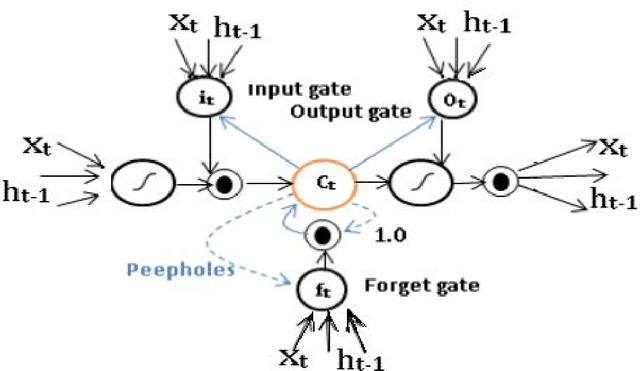

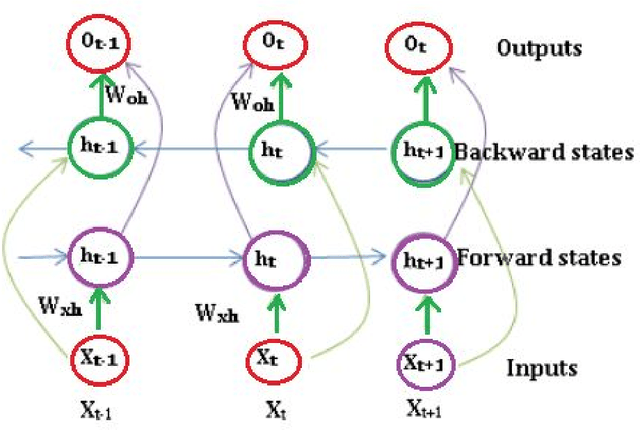
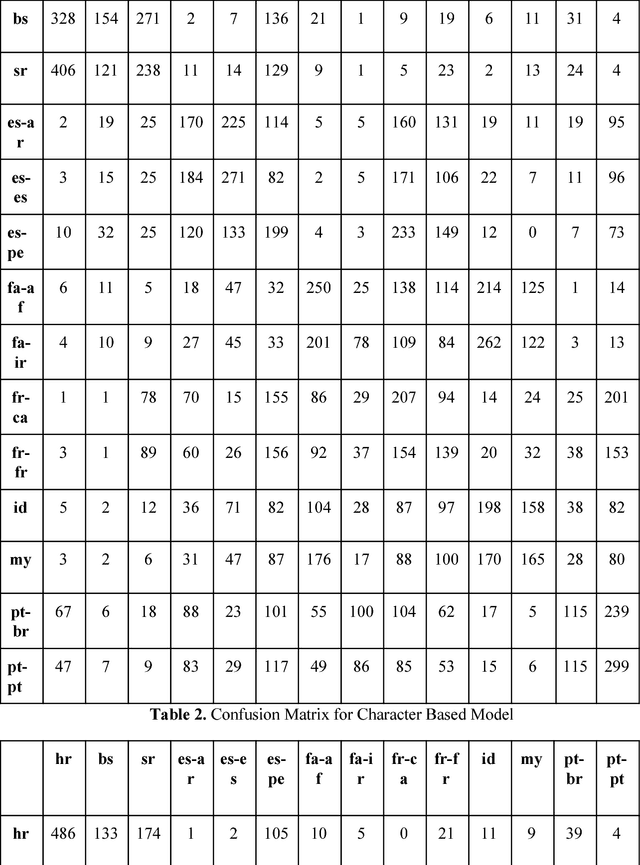
Abstract:Deep learning mechanisms are prevailing approaches in recent days for the various tasks in natural language processing, speech recognition, image processing and many others. To leverage this we use deep learning based mechanism specifically Bidirectional- Long Short-Term Memory (B-LSTM) for the task of dialectic identification in Arabic and German broadcast speech and Long Short-Term Memory (LSTM) for discriminating between similar Languages. Two unique B-LSTM models are created using the Large-vocabulary Continuous Speech Recognition (LVCSR) based lexical features and a fixed length of 400 per utterance bottleneck features generated by i-vector framework. These models were evaluated on the VarDial 2017 datasets for the tasks Arabic, German dialect identification with dialects of Egyptian, Gulf, Levantine, North African, and MSA for Arabic and Basel, Bern, Lucerne, and Zurich for German. Also for the task of Discriminating between Similar Languages like Bosnian, Croatian and Serbian. The B-LSTM model showed accuracy of 0.246 on lexical features and accuracy of 0.577 bottleneck features of i-Vector framework.
A short review on Applications of Deep learning for Cyber security
Dec 15, 2018Abstract:Deep learning is an advanced model of traditional machine learning. This has the capability to extract optimal feature representation from raw input samples. This has been applied towards various use cases in cyber security such as intrusion detection, malware classification, android malware detection, spam and phishing detection and binary analysis. This paper outlines the survey of all the works related to deep learning based solutions for various cyber security use cases. Keywords: Deep learning, intrusion detection, malware detection, Android malware detection, spam & phishing detection, traffic analysis, binary analysis.
Deep-Net: Deep Neural Network for Cyber Security Use Cases
Dec 09, 2018
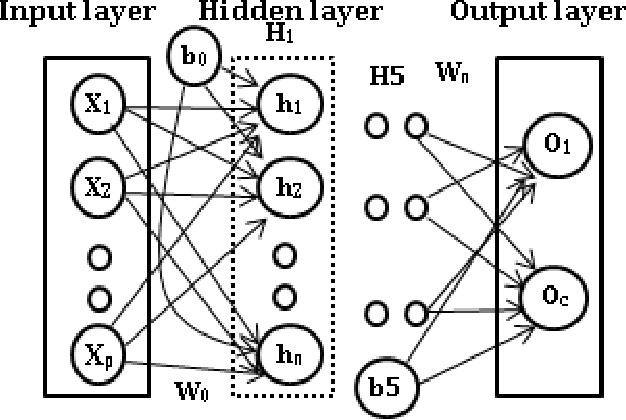
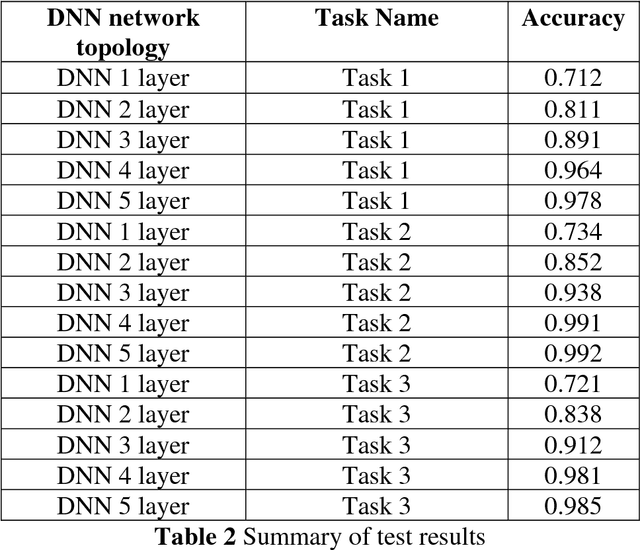

Abstract:Deep neural networks (DNNs) have witnessed as a powerful approach in this year by solving long-standing Artificial intelligence (AI) supervised and unsupervised tasks exists in natural language processing, speech processing, computer vision and others. In this paper, we attempt to apply DNNs on three different cyber security use cases: Android malware classification, incident detection and fraud detection. The data set of each use case contains real known benign and malicious activities samples. The efficient network architecture for DNN is chosen by conducting various trails of experiments for network parameters and network structures. The experiments of such chosen efficient configurations of DNNs are run up to 1000 epochs with learning rate set in the range [0.01-0.5]. Experiments of DNN performed well in comparison to the classical machine learning algorithms in all cases of experiments of cyber security use cases. This is due to the fact that DNNs implicitly extract and build better features, identifies the characteristics of the data that lead to better accuracy. The best accuracy obtained by DNN and XGBoost on Android malware classification 0.940 and 0.741, incident detection 1.00 and 0.997 fraud detection 0.972 and 0.916 respectively.
DeepImageSpam: Deep Learning based Image Spam Detection
Oct 03, 2018
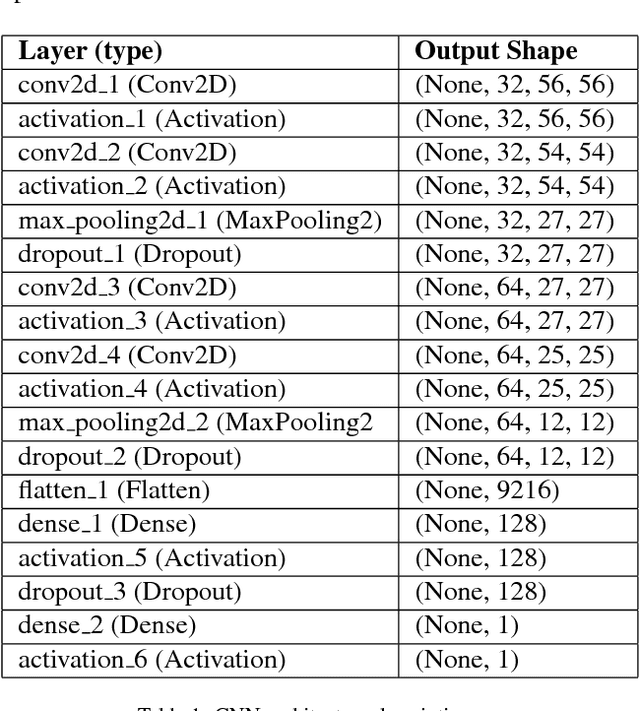

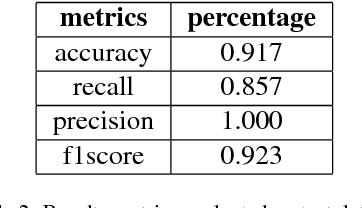
Abstract:Hackers and spammers are employing innovative and novel techniques to deceive novice and even knowledgeable internet users. Image spam is one of such technique where the spammer varies and changes some portion of the image such that it is indistinguishable from the original image fooling the users. This paper proposes a deep learning based approach for image spam detection using the convolutional neural networks which uses a dataset with 810 natural images and 928 spam images for classification achieving an accuracy of 91.7% outperforming the existing image processing and machine learning techniques
 Add to Chrome
Add to Chrome Add to Firefox
Add to Firefox Add to Edge
Add to Edge